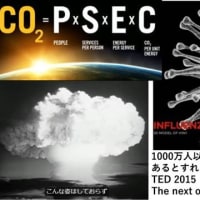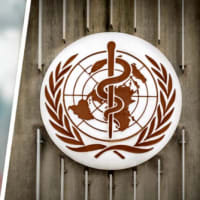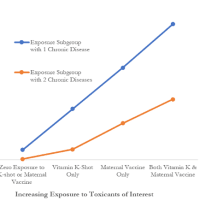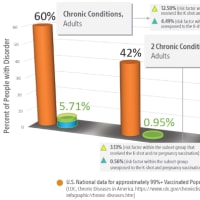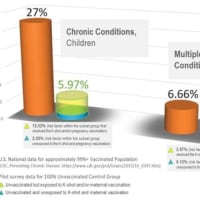CHDアセトアミノフェン自閉症・脳機能低下のリスク増加
訳注:
今回のCHDの記事
https://childrenshealthdefense.org/defender/tylenol-babies-children-vaccination-autism/
07/29/22 • Updated 07/30/22、2022年7月29日、改訂2022年7月30日
Childrens Health Defense子供の健康防衛
Tylenol Use in Babies, Children Raises Risk of Autism, New Review Shows
赤ちゃん、子供のタイレノール使用は自閉症のリスクを高める、新しいレビューは示す
この記事では、ワクチン・感染(例えば風邪)などにより発熱し酸化ストレスの増大に苦しむ子供は、体内の抗酸化剤のグルタチオンが低下しており、このような時に解熱剤のアセトアミノフェンを投与すれば、アセトアミノフェンの非常に毒性の高い代謝物である N-アセチル-p-ベンゾキノン イミン (NAPQI)が生成し、それを体内のグルタチオンにより除去できず、NAPQIにより脳の神経細胞が破壊され、子供が自閉症ASDを発症するリスクが高くなると説明されています。自閉症だけではなく、もっと軽度のその他の脳機能の低下や障害も起こるのも間違いありません。
では、ワクチン・風邪などによる発熱時に、安全を考えて世界で最も良く使用されている解熱鎮痛剤のアセトアミノフェンを使用しないとなると、どのようにすれば良いのでしょうか。
それについては、次のブログ記事を参照して下さい。
2023/03/02改訂 ビタミンCによる風邪・インフルエンザへの対処
https://blog.goo.ne.jp/gadamski/e/deb96ef5fcc744caf16ece7dce30437c
しかし、ワクチンには、脳のミクログリアの活性化と酸化ストレスの増大による脳神経細胞の破壊の問題もあります。これは、アセトアミノフェンがなくても起き、自閉症を起こします。
これについては、ブレイロック博士の記事参照
ラッセル・L・ブレイロック博士は、米国ミシシッピ州リッジランドにあるTheoretical Neuroscience Research、LLCの元脳神経外科医で、アメリカのワクチン薬害の専門家です。
このブログには次の記事があります。
アメリカの脳神経科医のラッセル・ブレイロック博士の栄養と行動に関する動画
ミクログリア活性化と神経変性: ラッセル L. ブレイロック博士の論説
No.1「ワクチン、神経発達、及び自閉症スペクトル疾患」ラッセル L. ブレイロック博士1
No.2「ワクチン、神経発達、及び自閉症スペクトル疾患」ラッセル L. ブレイロック博士2
No.3「ワクチン、神経発達、及び自閉症スペクトル疾患」ラッセル L. ブレイロック博士3
No.4「ワクチン、神経発達、及び自閉症スペクトル疾患」ラッセル L. ブレイロック博士4
No.5参考文献「ワクチン、神経発達、及び自閉症スペクトル疾患」ラッセル L. ブレイロック博士5
ワクチン安全マニュアル: ラッセル・ブレイロック博士による序文
2023/01/24追加 ラッセル・ブレイロック博士 COVIDワクチンがいかに脳を傷つけ、がんを引き起こすか
++++++++++++++++++++++++++++++++++++++++++++++++
https://childrenshealthdefense.org/defender/tylenol-babies-children-vaccination-autism/
07/29/22 • Updated 07/30/22、2022年7月29日、改訂2022年7月30日
Childrens Health Defense子供の健康防衛
Tylenol Use in Babies, Children Raises Risk of Autism, New Review Shows
赤ちゃん、子供のタイレノール使用は自閉症のリスクを高める、新しいレビューは示す
The authors of a new review of the drug acetaminophen (paracetamol), sold under the brand names Tylenol and Panadol, are sounding the alarm about the use of the drug in infants and children, citing the drug’s association with autism spectrum disorder (ASD).
Tylenol と Panadol というブランド名で販売されているアセトアミノフェン (パラセタモール) の新しいレビューの著者は、自閉症スペクトラム障害 (ASD) との関連性を引き合いに出し、乳児や子供へのこの薬の使用について警鐘を鳴らしています。
The authors of a new review of the drug acetaminophen (paracetamol), sold under the brand names Tylenol and Panadol, are sounding the alarm about the use of the drug in infants and children, citing the drug’s association with autism spectrum disorder (ASD).
Tylenol と Panadol というブランド名で販売されているアセトアミノフェン (パラセタモール) の新しいレビューの著者は、自閉症スペクトラム障害 (ASD) との関連性を引き合いに出し、乳児や子供へのこの薬の使用について警鐘を鳴らしています。
“Our study shows that acetaminophen would never be approved for pediatric use by today’s regulatory standards,” Dr. William Parker, of WPLab, Inc., who led the research team that conducted the review on acetaminophen and autism, told The Defender.
「私たちの研究は、アセトアミノフェンが今日の規制基準によって小児への使用が承認されることは決してないことを示しています」と、アセトアミノフェンと自閉症に関するレビューを実施した研究チームを率いた WPLab, Inc. の Dr. William Parker は The Defender に語った.
The review, published in the July issue of Minerva Pediatrics, offers 17 lines of evidence that the commonly used remedy for pain and fever may be contributing to the autism epidemic.
Minerva Pediatrics の 7 月号に掲載されたこのレビューは、一般的に使用されている痛みと熱の治療法が自閉症の流行に寄与している可能性があるという 17の証拠を提供しています。
The authors said their findings could have huge implications for preventing ASD, as acetaminophen is used so much in young children — in some populations, up to 90% of children receive acetaminophen in their early years.
著者らは、アセトアミノフェンは幼児に非常に多く使用されているため、彼らの発見はASDの予防に大きな影響を与える可能性があると述べました.一部の集団では、子供の最大90%が初期にアセトアミノフェンを投与されています.
The rate of ASD has skyrocketed in the last 40 years, and now affects 1 in 40 U.S. children.
ASD の割合は過去 40 年間で急増し、現在では米国の子供の 40 人に 1 人が罹患しています。
Acetaminophen became the drug of choice to treat fevers and pain in children in the early 1980s, after aspirin was associated with Reye’s syndrome.
アセトアミノフェンは、アスピリンがライ症候群と関連していた後、1980年代初頭に子供の発熱と痛みを治療するための選択薬になりました.
However, the use of acetaminophen in infants and children was never shown to be safe for neurodevelopment.
しかし、乳児や子供へのアセトアミノフェンの使用が神経発達に対して安全であるとは証明されていません。
“The belief that acetaminophen is safe for children is an assumption based on the fact many studies show it does not cause liver damage in children when used at an appropriate dose,” said Parker.
「アセトアミノフェンが子供にとって安全であるという信念は、多くの研究が、適切な用量で使用された場合、子供に肝障害を引き起こさないことを示しているという事実に基づいた仮定です.」とパーカーは言った。
(訳注: 肝障害以外の安全性の問題に関する証拠はない。)
Parker and his colleagues previously conducted a systematic review, published in February in the European Journal of Pediatrics, which showed the studies claiming acetaminophen is safe for children did not examine the effect of the drug on neurodevelopment — even though the brain is one of the primary target organs for the drug’s therapeutic effect.
パーカーと彼の同僚は以前に系統的レビューを実施し、2 月に European Journal of Pediatrics に掲載されました。
アセトアミノフェンが子供にとって安全であると主張する研究は、脳が薬物の治療効果の主要な標的臓器の1つであるにもかかわらず、神経発達に対する薬物の影響を調べていないことを示しました.
Their latest review builds on their earlier work showing acetaminophen was not assessed for impact on neurodevelopment, and on the strong evidence that prenatal exposure to acetaminophen increases the risks of neurodevelopmental issues.
彼らの最新のレビューは、アセトアミノフェンが神経発達への影響について評価されなかったことを示す以前の研究に基づいています。
また、出生前にアセトアミノフェンにさらされると、神経発達障害のリスクが高まるという強力な証拠に基づいています。
There is little research on the effect of postnatal exposure to acetaminophen.
出生後のアセトアミノフェンへの曝露の影響に関する研究はほとんどありません。
However, according to the study, “circumstantial evidence regarding postnatal exposure to the drug is abundant, and includes at least three otherwise unexplained temporal relationships, data from laboratory animal studies, several miscellaneous and otherwise unexplained correlations, and a lack of alternative suspects that fit the evidence-derived profile.”
しかし、研究によると、「出生後の薬物曝露に関する状況証拠は豊富であり、少なくとも 3 つの説明のつかない時間的関係、実験動物研究からのデータ、いくつかの雑多で説明のつかない相関関係、そして、証拠に基づいたプロファイルに適合する別の容疑者が不足しています。」
Based on this evidence, the authors “concluded without any reasonable doubt” that postnatal exposure to acetaminophen for children at risk is “responsible for many if not most cases of ASD.”
この証拠に基づいて、著者らは、危険にさらされている子供たちの出生後のアセトアミノフェンへの曝露は、「ASDのほとんどではないにしても多くの症例の原因である」と「合理的な疑いなく結論付けました」.
(訳注:
これは、自閉症には、アセトアミノフェが関連していることを示していますが、唯一の原因であることを示しているのではありません。ワクチンの成分も原因であり、むしろこちらの関連の方が大きいと考えられます。)
The risk factor: oxidative stress
危険因子:酸化ストレス
The key to understanding the role of acetaminophen in ASD is that acetaminophen alone does not trigger ASD — the negative impact happens in the presence of oxidative stress, according to Parker and his colleagues.
ASD におけるアセトアミノフェンの役割を理解するための鍵は、アセトアミノフェン単独では ASD を引き起こさないということです。Parker と彼の同僚によると、悪影響は酸化ストレスの存在下で起こります。
Oxidative stress is an imbalance of free radicals and antioxidants in the body that can lead to cell and tissue damage.
酸化ストレスは、体内のフリーラジカルと抗酸化物質の不均衡であり、細胞や組織の損傷につながる可能性があります.
The body’s cells produce free radicals during metabolism, the chemical reactions that produce energy in our cells.
体の細胞は、細胞内でエネルギーを生み出す化学反応である代謝中にフリーラジカルを生成します。
These free radicals cause damage to cells and contribute to chronic illnesses and the aging process.
これらのフリーラジカルは細胞に損傷を与え、慢性疾患や老化プロセスの一因となります.
Unlike many drugs, some of the acetaminophen an individual takes is converted by the body into a highly toxic metabolite, N-acetyl-p-benzoquinone imine (NAPQI).
多くの薬物とは異なり、個人が摂取するアセトアミノフェンの一部は、体内で非常に毒性の高い代謝物である N-アセチル-p-ベンゾキノン イミン (NAPQI) に変換されます。
Usually, NAPQI is rapidly neutralized (rendered harmless) by glutathione, and because most healthy children have lots of glutathione, they aren’t harmed by NAPQI.
通常、NAPQI はグルタチオンによって急速に中和 (無害化) されます。ほとんどの健康な子供はグルタチオンが多く含あるため、NAPQI によって害を受けることはありません。
However, under conditions of oxidative stress, glutathione is depleted so the body can’t adequately remove the NAPQI.
しかし、酸化ストレスの条件下では、グルタチオンが枯渇するため、体はNAPQIを適切に除去できません.
Left unremoved, the NAPQI reacts with a wide range of proteins, causing permanent damage to the proteins and associated cells.
NAPQI を除去せずに放置すると、さまざまなタンパク質と反応し、タンパク質と関連細胞に永久的な損傷を与えます。
Many babies and children are exposed to excessive oxidative stress through a variety of environmental and genetic factors including infection, treatment with antibiotics, vaccination, psychological stress, jaundice, heavy metals, problems with vitamin B metabolism, EMF exposure, exposure to cigarette smoke or air pollution and exposure to organophosphates.
多くの赤ちゃんや子供は、感染、抗生物質による治療、ワクチン接種、心理的ストレス、黄疸、重金属、ビタミン B 代謝の問題、EMF 曝露、タバコの煙や大気汚染への曝露、有機リンへの暴露など、さまざまな環境的および遺伝的要因を通じて過度の酸化ストレスにさらされています。
How likely a child is to be injured by acetaminophen depends in part on the amount of oxidative stress present when the child takes the acetaminophen and the amount of the drug administered to the child.
子供がアセトアミノフェンによってどの程度損傷を受ける可能性があるかは、子供がアセトアミノフェンを服用したときに存在する酸化ストレスの量と、子供に投与される薬物の量に部分的に依存します.
According to the authors of the review, understanding the role of oxidative stress in combination with acetaminophen contributes to our understanding of the disparate risk factors for ASD: They are sources of oxidative stress.
レビューの著者によると、アセトアミノフェンと組み合わせた酸化ストレスの役割を理解することは、ASD のさまざまな危険因子を理解するのに役立ちます。それらは酸化ストレスの原因です。
When a child develops a fever after receiving a vaccine, it’s an indication the child is experiencing oxidative stress.
ワクチン接種後に子供が発熱した場合、それは子供が酸化ストレスを経験していることを示しています。
Giving acetaminophen to a child in the throes of oxidative stress increases the child’s risk of developing ASD, according to Parker.
パーカーによれば、酸化ストレスに苦しんでいる子供にアセトアミノフェンを与えると、子供がASDを発症するリスクが高くなります.
(訳注:
ワクチン・感染などにより発熱し酸化ストレスの増大に苦しむ子供は、抗酸化剤のグルタチオンが低下しており、解熱剤のアセトアミノフェンを投与すれば、アセトアミノフェンの非常に毒性の高い代謝物である N-アセチル-p-ベンゾキノン イミン (NAPQI)を除去できず、脳の神経細胞が破壊され、子供がASDを発症するリスクが高くなると説明されています。
しかし、ワクチンには、脳のミクログリアの活性化と酸化ストレスの増大による神経細胞の破壊の問題もあります。これは、アセトアミノフェンがなくても起き、自閉症を起こします。)
First indication that acetaminophen might be associated with ASD
アセトアミノフェンが ASD と関連している可能性を示す最初の兆候
Parker told The Defender the first indication that acetaminophen might have a negative impact on neurodevelopment came from the work of Dr. Stephen Schultz, who watched his child regress into ASD in 1996, after routine childhood vaccination followed by giving his child acetaminophen.
パーカーはディフェンダーに、アセトアミノフェンが神経発達に悪影響を与える可能性があるという最初の兆候は、スティーブン・シュルツ博士の研究から得られたと語った.
彼は、1996 年に小児期に定期的にワクチンを接種した後、子供にアセトアミノフェンを投与した後、子供が ASD に退行するのを見ました。
After his son’s “slow slide” into autism, Schultz left his established dentistry practice and went on a journey to find out what happened to his child, earning a Ph.D. in the process.
息子が自閉症になった後、シュルツは確立された歯科医院を離れ、自分の子供に何が起こったのかを調べる旅に出て、その過程の中で博士号を取得しました。
In 2008, Schultz and a number of distinguished scientists, then at the University of California, San Diego and at San Diego State University, published a small survey study that showed a six-fold increased risk of ASD in 1-to 5-year-old children when routine childhood vaccines were accompanied with acetaminophen versus ibuprofen.
2008 年、シュルツと、当時カリフォルニア大学サンディエゴ校とサンディエゴ州立大学に在籍していた多くの著名な科学者が、小規模な調査研究を発表しました。
定期的な小児期ワクチンにアセトアミノフェンを併用した場合、イブプロフェンと比較して、1~5 歳の小児の ASD のリスクが 6 倍に増加したことが示されました。
“Unfortunately,” Parker said, “Schultz’s study was ignored for almost a decade.” The study was criticized for being small.
「残念ながら、シュルツの研究はほぼ 10 年間無視されていました。」 この研究は規模が小さいと批判された.
Parker conceded a study like this, taken in isolation, does not seem persuasive. However, he said, it should be considered as just one piece of the big picture of what is causing the dramatic increase in ASD.
Parker は、このような研究を単独で行った場合、説得力がないように思われることを認めました。 しかし、それはASDの劇的な増加を引き起こしているものの全体像のほんの一部と見なされるべきである.
As Jennifer Margulis, Ph.D., wrote in her Substack post on Parker’s paper, “In a nutshell, it’s impossible to see a big picture with a scientific microscope.”
Jennifer Margulis 博士が Parker の論文の Substack の投稿で書いたように、「一言で言えば、科学的顕微鏡で全体像を見ることは不可能です。」
A narrative review of the evidence
証拠の物語的レビュー
The goal of Parker’s latest study was to pull together the many pieces of evidence in order to better understand the big picture.
パーカーの最新の研究の目標は、全体像をよりよく理解するために多くの証拠をまとめることでした.
The study is a narrative review that presents the 17 lines of evidence suggesting acetaminophen is associated with ASD and examines the alternative explanations.
この研究は、アセトアミノフェンが ASD に関連していることを示唆する 17 の証拠を提示し、別の説明を検討するナラティブ レビューです。
Highlights from the review include:
レビューのハイライトは次のとおりです。
- Acetaminophen use in pregnancy is neurotoxic to babies, with long-term effects that include lower IQ, increased ASD and increased ADHD.
- 妊娠中のアセトアミノフェンの使用は、IQ の低下、ASD の増加、ADHD の増加などの長期的な影響を伴い、赤ちゃんに神経毒性をもたらします。
The authors conclude if babies can be harmed by acetaminophen in utero, it’s unreasonable to think they couldn’t also be harmed by the drug after birth.
著者らは、胎児が子宮内でアセトアミノフェンによって害を受ける可能性がある場合、出生後にもアセトアミノフェンによって害を受けないと考えるのは不合理であると結論付けています.
- Studies on ratsand mice showed acetaminophen causes long-term brain damage, and this early exposure to the drug was at doses that are similar to or even less than doses received by human babies and children.
- ラットとマウスに関する研究では、アセトアミノフェンが長期的な脳損傷を引き起こすことが示されました。
そして、この薬物への初期の曝露は、人間の赤ちゃんや子供が受ける用量と同じか、それよりも少ない用量でした.
An alternative explanation is that rat and mouse pups are more sensitive to acetaminophen than human babies.
別の説明は、ラットとマウスの子犬は、人間の赤ちゃんよりもアセトアミノフェンに敏感であるというものです.
However, the authors point out that lab animals are often less sensitive to toxins, such as the heavy metal lead and the insecticide DDT.
しかし、著者らは、実験動物は重金属の鉛や殺虫剤 DDT などの毒素に対して感受性が低いことが多いと指摘しています。
- The incidence of ASD began to increase in the early 1980s, coinciding with the discovery aspirin was associated with Reye’s syndrome and the resulting switch from using aspirin in children to using acetaminophen.
- ASD の発生率は 1980 年代初頭に増加し始めました。これは、アスピリンがライ症候群と関連していることが発見され、その結果、子供へのアスピリンの使用からアセトアミノフェンの使用への切り替えが行われたことと一致しています。
The authors argue this was not a coincidence.
著者は、これは偶然ではないと主張しています。
- The incidence of ASD steadily increasedin the U.S., after the U.S. Food and Drug Administration (FDA) eased restrictions on direct-to-consumer advertising in 1997.
- 米国食品医薬品局 (FDA) が 1997 年に消費者向け広告の規制を緩和した後、ASD の発生率は米国で着実に増加しました。
That, and other factors, may have increased the use of pharmaceutical products.
それと他の要因により、医薬品の使用が増加した可能性があります。
- The circumcision of baby boys is associated with a dramatic increase (50%) in the risk for early-onset ASD.
- 男の子の割礼は、早発性 ASD のリスクの劇的な増加 (50%) と関連しています。
Acetaminophen is frequently used to relieve pain caused by circumcision.
アセトアミノフェンは、割礼による痛みを和らげるためによく使用されます。
- The combination of the measles-mumps-rubella (MMR) vaccine with the use of acetaminophen is associated with higher risk of ASDthan MMR vaccination alone.
- 麻疹-おたふく風邪-風疹 (MMR) ワクチンとアセトアミノフェンの併用は、MMR ワクチン単独よりも ASD のリスクが高くなります。
“Many parents believe that their children’s ASD was induced by a vaccine based on their own observations or the observations of trusted social networks.”
「多くの親は、自分の観察や信頼できるソーシャル ネットワークの観察に基づいて、子供の ASD がワクチンによって誘発されたと信じています。」
However, the authors argue the vaccination caused oxidative stress.
しかし、著者は、ワクチン接種が酸化ストレスを引き起こしたと主張している.
The subsequent administration of acetaminophen — not the vaccine — then triggered the ASD.
ワクチンではなく、その後のアセトアミノフェンの投与が ASD の引き金となった。
(訳注:
ワクチン・感染などにより発熱し酸化ストレスの増大に苦しむ子供は、抗酸化剤のグルタチオンが低下しており、解熱剤のアセトアミノフェンを投与すれば、アセトアミノフェンの非常に毒性の高い代謝物である N-アセチル-p-ベンゾキノン イミン (NAPQI)を除去できず、脳の神経細胞が破壊され、子供がASDを発症するリスクが高くなると説明されています。
しかし、ワクチンには、脳のミクログリアの活性化と酸化ストレスの増大による神経細胞の破壊の問題もあります。これは、アセトアミノフェンがなくても起き、自閉症を起こします。)
- People with cystic fibrosis, who are unusually efficient at metabolizing acetaminophen, have a low incidence of ASD.
- アセトアミノフェンの代謝が異常に効率的な嚢胞性線維症の人は、ASD の発生率が低い。
- In South Korea, where acetaminophen-containing products were repeatedly found to contain amounts of the drug exceeding the package label, researchers found an unexpectedly high prevalence of ASD.
- アセトアミノフェン含有製品にパッケージラベルを超える量の薬物が含まれていることが繰り返し発見された韓国では、研究者は予想外に高い ASD 有病率を発見しました。
What can parents do instead? Alternatives to acetaminophen
代わりに、親は何ができますか? アセトアミノフェンの代替
What will it take to change the authorization of acetaminophen for children or at least get a black box warning on the drug?
子供のためのアセトアミノフェンの承認を変更したり、少なくとも薬物に関する黒枠の警告を取得するには何が必要ですか?
Parker contacted the FDA, but said, “The way the tide was turned with aspirin and Reye’s Syndrome was through grassroots efforts.”
パーカーは FDA に連絡したが、FDAは、「アスピリンとライ症候群で流れが変わったのは、草の根の努力によるものだった」と述べた.
In the meantime, the narrative review by Parker and his colleagues is there for parents and caregivers who want to review the evidence and decide for themselves if acetaminophen is worth the risk for babies and young children.
それまでの間、Parker と彼の同僚によるナラティブ レビューは、エビデンスをレビューし、アセトアミノフェンが乳児や幼児にとってリスクに見合う価値があるかどうかを自分で判断したい親や介護者のためにあります。
“In my experience, with very rare exceptions, parents who are aware of the available evidence will avoid giving acetaminophen to their babies and children,” said Parker.
「私の経験では、非常にまれな例外を除いて、利用可能な証拠を知っている親は、赤ちゃんや子供にアセトアミノフェンを与えることを避けるでしょう.」とパーカーは言いました。
Unlike some potential causes of autism, acetaminophen is one risk factor that parents, caregivers and physicians can often eliminate with ease, Parker said.
自閉症のいくつかの潜在的な原因とは異なり、アセトアミノフェンは、親、介護者、および医師がしばしば簡単に排除できる危険因子の1つです.、とパーカーは言いました。
For parents looking for alternatives to treat fevers in children, Parker recommended the “Treating a Fever Without Medicine” resource from the American Academy of Pediatrics, with tips such as offering plenty of fluids and sponging the child.
子供の熱を治療するための代替手段を探している親のために、パーカーは、米国小児科学会の「薬を使わずに熱を治療する」リソースを推奨しました。
十分な水分を提供したり、子供にスポンジを塗ったりするなどのヒントがあります。
Margulis suggested a range of natural remedies to treat pain and fever in children.
マルグリスは、子供の痛みや熱を治療するためのさまざまな自然療法を提案しました.
Updated: This article was updated to state that the authors are sounding the alarm about the use of Tylenol in infants and children, but did not call for an immediate end to its use.
更新: この記事は更新され、著者は乳児や子供へのタイレノールの使用について警鐘を鳴らしているが、その使用を直ちに中止するようには求めていない.
Julie Comber is a freelance science reporter for The Defender.
ジュリー・コンバー博士
Julie Comber は、The Defender のフリーランスの科学レポーターです。
+++++++++++++++++++
参考情報
妊娠中のアセトアミノフェン暴露が子供の自閉症、ADHDと関連
(1)妊娠中のアセトアミノフェンの使用が子供の神経発達を阻害
(a)スペインの出生コホート2644母子ペアーを妊娠中にリクルート。1歳と5歳の時に評価した生誕参加者は88.8%と79.9%。子供自閉症スペクトラム試験CAST、コナーズ幼児用持続的注意集中力検査K-CPT、ADHD-DSM-IVリストにより評価。
(b)結果: 40%以上の母親がアセトアミノフェンの使用を報告。
暴露された子供は、活動過剰/衝動性症状(発生率比IRR=1.41, 95%CI 1.01-1.98)、K-CPT過失(IRR = 1.10, 1.03–1.17)、検出スコアーの低下(係数 β = −0.75, −0.13–−0.02)が見られた。暴露された少年ではCASTスコアが増加した(β = 0.63, 0.09–1.18)。
使用頻度によるリスクの効果サイズの増加が、全ての子供で活動過剰/衝動性症状(発生率比IRR = 2.01, 0.95–4.24に関して、少女ではK-CPT過失(IRR = 1.32, 1.05–1.66)と検出率(β = −0.18, −0.36–0.00)に関して、少年ではCASTスコア(β = 1.91, 0.44–3.38)に関して観察された。(1)
(1)Int. J. Epidemiol. (2016) doi: 10.1093/ije/dyw11
First published online: June 28, 2016
Acetaminophen use in pregnancy and neurodevelopment: attention function and autism spectrum symptoms
Claudia B. Avella-Garcia1,2,3,4,5, Jordi Julvez1,3,6,*, Joan Fortuny7, Cristina Rebordosa7, Raquel García-Esteban1,3,6, Isolina Riaño Galán8, Adonina Tardón6,9, Clara L. Rodríguez-Bernal10, Carmen Iñiguez10, Ainara Andiarena11,12, Loreto Santa-Marina6,12,13 and Jordi Sunyer1,3,4,5
(2)妊娠中のアセトアミノフェン暴露が子供の自閉症、ADHDと関連
2017年1月までのMEDLINE, EMBASE, Cochraneを検索。7つの入手可能な後ろ向きコホートは、132,731の母子ペアーを含み、追跡期間は3-11年。
蓄積リスク比RRは、ADHDではRR=1.32, 95% CI 1.18,1.45, I2=61%、ASD 自閉症スペクトラム障害ではRR=1.23, 95% CI1.13,1.32, I2=17%、活動過剰症状RR=1.23, 95% CI 1.01,1.49, I2=94%。メタ回帰分析で、暴露とADHDの間の関連は、追跡の際の子供の年齢と暴露の平均期間に伴い増加した(β=0.0354, 95% CI 0.001,0.07), (β=0.006, 95% CI 0.009,0.01)。妊娠中のアセトアミノフェンは、ADHD、ASD、活動過剰症状のリスクの増加と関連する。(2)
(2)Prenatal Exposure to Acetaminophen and Risk for Attention Deficit Hyperactivity Disorder and Autistic Spectrum Disorder: A Systematic Review, Meta-Analysis, and Meta-Regression Analysis of Cohort Studies
Reem Masarwa Hagai Levine Einat Gorelik Shimon Reif Amichai Perlman Ilan Matok
American Journal of Epidemiology, kwy086, https://doi.org/10.1093/aje/kwy086
Published: 24 April 2018
(3)出生前のアセトアミノフェンと自閉症・ADHDの関連
(a)方法: 6つのヨーロッパの人口ベースの出生/子供コホートの共同研究でこの関連を研究することを目指した。
合計73,881の母子ペアが研究に含まれた。アセトアミノフェンへの暴露は、母親のアンケートまたはインタビューを通じて評価された。ASCおよびADHDの症状は、4~12歳で評価された。
(b)結果: 境界性/臨床症状を持つ子供の割合は、ASCで0.9~12.9%、ADHDで1.2~12.2%。
出生前にアセトアミノフェンに曝露された子供は、暴露されていない子供たちと比較して、境界性または臨床的ASC(OR = 1.19、95%CI 1.07–1.33)およびADHD症状(OR = 1.21、95%CI 1.07–1.36)を発症する可能性が19%および21%高い。(3)
*自閉症スペクトラム状態 (ASC)、注意欠陥/多動性障害 (ADHD)
(3)Alemany, S., Avella-García, C., Liew, Z. et al.
Prenatal and postnatal exposure to acetaminophen in relation to autism spectrum and attention-deficit and hyperactivity symptoms in childhood: Meta-analysis in six European population-based cohorts.
自閉症スペクトラムと小児期の注意欠陥および多動性症状に関連した出生前および出生後のアセトアミノフェンへの暴露: 6 つのヨーロッパの人口ベースのコホートにおけるメタ分析。
Eur J Epidemiol (2021). https://doi.org/10.1007/s10654-021-00754-4
https://link.springer.com/article/10.1007/s10654-021-00754-4











